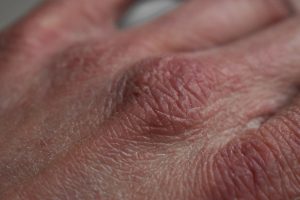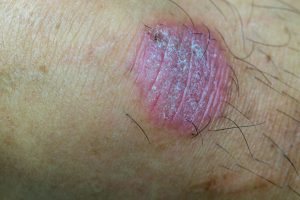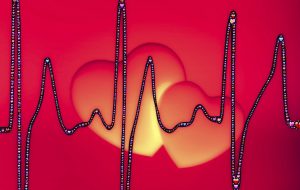Having thick skin can be a positive thing if we’re talking about how well you respond to criticism, but what about having actual thick skin? Thick skin could be a sign of an autoimmune rheumatic disease known as scleroderma. June is National Scleroderma Awareness Month, so to better understand this rare condition, we’re going to look at its symptoms, how it is diagnosed, and the treatments available for it. This disease presents itself differently from person to person, but it can be very serious: as many as 10,000 people die each year from it. The exact cause of this condition is unknown, but there is some promising research that is examining the relationship between the immune system and scleroderma.
What Is Scleroderma?
Scleroderma is an autoimmune rheumatic disease that affects more women than men and occurs mainly in people between the ages of 30 and 50. People with this disease will experience issues with their skin and other organs. While symptoms vary from person to person, the most visible and common symptom is hardening of the skin. Other symptoms can range from mild to life threatening; the seriousness of each symptom depends on what part of the body is affected. If scleroderma is not treated, it can become more serious over time.
What Causes It?
Scleroderma is not genetic or contagious, and it is not a type of cancer or infection. Researchers are still looking into the disease to figure out exactly what causes it. What they do know is that something within the person’s immune system triggers it, and that it causes the body to produce too much collagen, which is what causes the hardening, thickening and tightening of the skin, tendons, joints, and internal organs. It’s possible that environmental factors can trigger scleroderma, and, although it is not necessarily genetic, babies who developed morphea, the most common type of scleroderma, are more likely to have a blood relative who has or has had it. More research needs to be conducted to figure out the exact cause.
Types of Scleroderma
There are four different types of scleroderma, which affect different parts of the body, and which are classified in two different ways. The two classifications are localized scleroderma, which is usually found on a few patches of skin or muscles and rarely spreads anywhere else. The other classification is systemic scleroderma, which affects connective tissues in many parts of the body, including the internal organs. The four different types that fall under the two classifications are:

Localized Scleroderma:
- Morphea– This is the most common type of scleroderma. Firm, oval-shaped patches can occur on the chest, stomach, back, face, arms, and legs.
- Linear– With this type, a single line of thickened skin typically runs down the leg, arm, or forehead.
Systemic Scleroderma
- Limited– Thick skin is restricted to certain areas of the body, such as fingers, hands, face, lower arms, and legs. The symptoms of this type include calcinosis (calcium deposits in tissue), visible blood vessels, and impaired esophageal function.
- Diffuse– Thick skin covers a lot of the body in a symmetrical pattern. Skin can swell and become itchy; over time, it will affect your organs, including your kidneys, lungs, heart, and digestive tract. This is a rare type of scleroderma.
Symptoms
There are a variety of signs and symptoms of scleroderma to watch out for, including:
- Hard, thickening, or tight skin- Typically there will be at least 1 or 2 patches of hard, thick skin on the body. The patches will feel hard and as if you cannot move them.
- Hair loss and reduced sweating- The area where there is hardened skin will be shiny, hairless, discolored, and will not produce sweat.
- Dry, itchy skin
- Skin color changes- The affected patches of skin might be lighter or darker than your natural skin color. If a patch is violet in color, that means the scleroderma is growing.
- Stiff joints– You will have difficulty moving your joints because of the hard, thickening, or tight patches that have formed over the skin.
- Muscle shortening and weakness
- Loss of tissue beneath the skin
- Loss of muscle, cartilage, and bone, also known as Parry-Romberg syndrome
- Bone deformities- These usually occur in children who are still growing
- Skin sores
- Visible blood vessels near the surface of swollen skin
- Calcium deposits beneath the skin, also known as calcinosis

There are specific signs that scleroderma is affecting your internal organs, including:
- Problems swallowing
- Constipation
- Diarrhea
- Heartburn
- Bloated feeling after eating
- Weight loss without trying
- Abnormal heartbeat
- Lack of sex drive
Diagnosing Scleroderma
If you experience any of the symptoms above, you should see a dermatologist (skin specialist) or rheumatologist (arthritis specialist). They will conduct a physical exam, ask about your medical history, and give you a blood test, X-rays and a CT scan to determine if the condition is only affecting your skin or is affecting your internal organs as well.
Treatment
If your doctor confirms that you have scleroderma, it is important to get treatment as soon as possible. Physical and occupational therapy can help you straighten and bend your joints so you can maintain a normal life. If caught early, there are treatments such as phototherapy and medications that can actually clear up your scleroderma. If the condition mainly affects your skin, a dermatologist can offer different forms of treatment ranging anywhere from a moisturizer for dry skin to light and laser treatments for darkened skin or morphea. There is also a lot of ongoing research into new treatments for scleroderma.
There is no known cause of scleroderma, meaning we don’t know who could end up being affected by it. That is why it is important to shed light on this disease: if people learn about the symptoms and get checked out, they will have a better chance of treating it and getting rid of it before it gets worse. It’s important to know that, while the hardened skin can clear up on its own within a couple of years, the more serious forms of scleroderma can be life threatening. Treating it early can prevent any serious issues, and having good health insurance will help with costs.
Undergoing testing for conditions like scleroderma can be costly, and if you need any therapy, that could end up costing you even more money. Health insurance plays a big role in how much everything will cost, and having a plan that meets your needs can save you a lot of money. If you would like to compare plans in your area to find the one that is right for you and saves you money, we can help. We will compare plans in minutes and find a more personalized and affordable plan, for free. To get started, simply enter your zip code in the bar above, or to speak to a licensed agent, call 888-350-1890. No hassle or obligation.